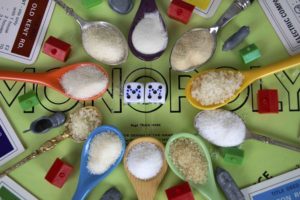The Science of Bloom
Gelatine is actually easy to use!!!
Many people think that there is an art to using gelatine – but really it is more like a science, and by following a few simple rules you should get good results every time.

One word that can be confusing is “bloom“. This is because it has two different meanings when it is referring to using gelatine.
- The first use of the word Bloom is in reference to the setting strength. The gelling strength is indicated by the figure given as its “Bloom” – starting at approx 90 Bloom (the weakest) to 300 Bloom (the strongest). This rather odd sounding unit was named after the man who developed the test for gelatine in 1925, a Mr Oscar T Bloom.
The powder sold in supermarkets in the UK is usually a 120 Bloom.

Professional sweet makers etc use strengths between 220 – 250 bloom.
If you are thinking about the 240 bloom you will use between a half to a third less than supermarket powder. You will need to experiment with the quantity of gelatine to use but I would start with about half the amount that you normally use, and see if that is enough. There is no difference in taste.
For special effects makeup, prosthetics and ballistics testing the 300 bloom (which I also sell) is generally used.
Getting the BEST from your Gelatine
The second use of the word Bloom is what you need to do to prepare the powder for use.
You will need to “bloom” the gelatine before you use it:
- Soak the gelatine for 30 min’s or more in 3 to 4 times its own weight of cold water or other liquid
- Heat this mixture up gently over some form of double boiler, or in the microwave, until it forms a clear liquid.
NB Never allow to boil, or use boiling water, as this affects the strength.

You also need to be careful about what you are trying to gel, for example Lemon juice will require more gelatine to set than water will.
Some fruits contain enyzmes called proteases which stops the gelatine from setting. These fruits need to be heated to inactivate the enyzmes. (eg pineapple, kiwi, figs, papaya, mango, guava and ginger root)
